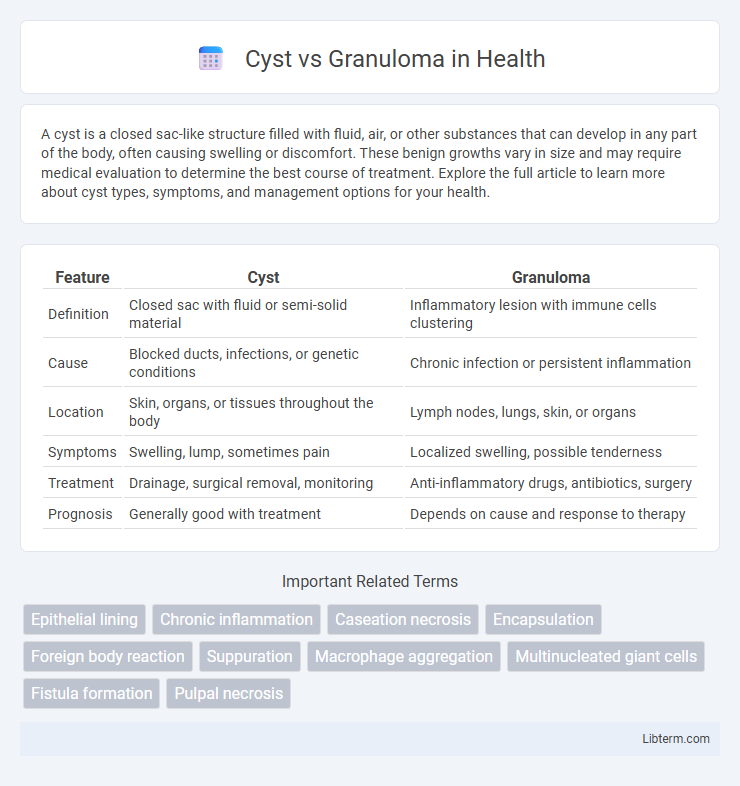A cyst is a closed sac-like structure filled with fluid, air, or other substances that can develop in any part of the body, often causing swelling or discomfort. These benign growths vary in size and may require medical evaluation to determine the best course of treatment. Explore the full article to learn more about cyst types, symptoms, and management options for your health.
Table of Comparison
| Feature | Cyst | Granuloma |
|---|---|---|
| Definition | Closed sac with fluid or semi-solid material | Inflammatory lesion with immune cells clustering |
| Cause | Blocked ducts, infections, or genetic conditions | Chronic infection or persistent inflammation |
| Location | Skin, organs, or tissues throughout the body | Lymph nodes, lungs, skin, or organs |
| Symptoms | Swelling, lump, sometimes pain | Localized swelling, possible tenderness |
| Treatment | Drainage, surgical removal, monitoring | Anti-inflammatory drugs, antibiotics, surgery |
| Prognosis | Generally good with treatment | Depends on cause and response to therapy |
Understanding the Basics: What Are Cysts and Granulomas?
Cysts are closed sac-like structures filled with fluid, air, or semi-solid material, commonly forming in tissues such as skin, organs, or bones, often caused by infections, blockages, or chronic inflammation. Granulomas are small nodules of chronic inflammation composed of immune cells, typically macrophages, that form as a response to persistent irritants like infections (e.g., tuberculosis) or foreign substances. Understanding the distinct nature of cysts as fluid-filled cavities and granulomas as immune cell aggregates is crucial for accurate diagnosis and targeted treatment in medical practice.
Key Differences Between Cysts and Granulomas
Cysts are closed sac-like structures filled with fluid, semisolid, or gaseous material, often encapsulated by an epithelial lining, while granulomas are small nodular inflammations composed of clustered immune cells, particularly macrophages. Cysts typically develop due to blockages or developmental anomalies, whereas granulomas form as a result of chronic inflammation to isolate persistent irritants like infections or foreign substances. Diagnostic imaging and histopathological examination reveal distinct structural and cellular differences critical for treatment decisions and prognosis.
Causes: Why Do Cysts and Granulomas Form?
Cysts form due to blockages in ducts or infections that lead to fluid accumulation within a closed sac, often triggered by factors such as chronic inflammation, trauma, or obstructed glands. Granulomas develop as a result of the immune system's response to persistent irritants like bacteria, fungi, or foreign substances that the body cannot easily eliminate, causing clusters of immune cells to wall off these agents. Understanding the underlying causes of cysts and granulomas is essential for accurate diagnosis and targeted treatment strategies.
Common Types of Cysts and Granulomas
Common cyst types include epidermoid cysts, which are benign and filled with keratin, and sebaceous cysts, originating from blocked oil glands. Granulomas frequently present as tuberculous granulomas, driven by Mycobacterium tuberculosis infection, and sarcoid granulomas, associated with sarcoidosis characterized by non-caseating granulomatous inflammation. Differentiating these lesions involves recognizing the cysts' enclosed sac-like structure versus granulomas' immune cell aggregation responding to chronic inflammation.
Symptoms: How Cysts and Granulomas Present
Cysts typically present as painless, slow-growing lumps beneath the skin or within organs, sometimes causing discomfort if they become infected or inflamed. Granulomas often manifest as small, firm nodules that may be tender or red, frequently developing in response to infection, inflammation, or foreign substances. Both conditions can vary in size and symptoms, with cysts more likely to cause swelling and granulomas often linked to chronic inflammatory processes.
Diagnostic Methods for Identifying Cysts vs Granulomas
Diagnostic methods for differentiating cysts from granulomas primarily include clinical examination, radiographic imaging, and histopathological analysis. Radiographs reveal cysts as well-defined radiolucent lesions with cortical borders, while granulomas typically present as ill-defined periapical radiolucencies without a distinct lining. Definitive diagnosis relies on biopsy and microscopic evaluation, where cysts exhibit an epithelial lining, contrasting with the inflammatory cell infiltrate characteristic of granulomas.
Treatment Options for Cyst and Granuloma Management
Treatment options for cysts include surgical excision, marsupialization, or aspiration depending on size and location, while granuloma management typically involves corticosteroid injections, laser therapy, or surgical removal if persistent. Cysts may also require antibiotics if infected, whereas granulomas often respond to addressing underlying inflammation or infection. Early diagnosis ensures tailored treatments, minimizing complications and promoting faster recovery for both conditions.
Complications: Potential Risks of Untreated Lesions
Untreated cysts can lead to infection, abscess formation, and possible tissue damage due to continued growth or rupture. Granulomas, if not managed, may cause chronic inflammation, tissue fibrosis, and impaired organ function depending on their location. Both lesions pose risks of secondary infections and complications like pain, swelling, and interference with nearby structures.
Prevention Strategies for Cyst and Granuloma Development
Effective prevention strategies for cyst and granuloma development include maintaining rigorous oral hygiene to reduce bacterial infection risk and avoiding trauma to tissues during dental procedures. Regular dental check-ups enable early detection and management of irritants such as impacted teeth or foreign bodies that can trigger cyst or granuloma formation. Using sterile techniques and proper wound care minimizes inflammation, thereby lowering the likelihood of cystic or granulomatous lesions.
When to Seek Medical Attention for Lumps and Lesions
Seek medical attention for cysts or granulomas when lumps rapidly grow, become painful, or show signs of infection such as redness, warmth, or discharge. Persistent or enlarging lesions that do not improve within two weeks warrant evaluation by a healthcare professional to rule out malignancy or chronic infection. Early diagnosis and treatment can prevent complications and ensure appropriate management.
Cyst Infographic

 libterm.com
libterm.com